If you have a weak stomach, you may want to turn away now. Parasitism is unpleasant at the best of times, but occasionally it can get downright creepy. Some organisms have perfected the art of infection to the point of controlling the minds and behavior of their hosts. I’ve previously discussed Toxoplasma gondii, a behavior-altering parasite that has spread to infect over a third of the human population, but there are many other parasites that infect non-human hosts in more extreme ways. While the examples I have included in this post are not exhaustive by any means, they are some of the most bizarre and spine-chilling examples of parasites taking control.
Glyptapanteles: Creators of Zombie Bodyguards
If you really want to get the most out of the creature hosting your eggs and larvae, look no further than the parasitic wasps, Glyptapanteles, for inspiration. Not only do these charming wasps use a host to incubate their eggs, but, once hatched, the larvae proceed to control the host’s mind and turn it into a bodyguard!
Glyptapanteles wasps utilize various moth caterpillars as their hosts across the Americas. An adult, female wasp will rudely interrupt a caterpillar’s leafy feast to inject her eggs. The caterpillar will quickly recover and continue chewing on leaves as the eggs hatch inside of it (caterpillars are not the smartest of creatures). Over the span of two weeks, the larvae will grow within the host caterpillar, using its innards as tasty nutrients. At the end of these two weeks, up to 80 fully-grown larvae will come bursting out of the quite unfortunate host. Unfortunately, that’s hardly the end of the caterpillar’s trauma[6].
One or two larvae remain within the partially consumed caterpillar while their fellows begin to pupate. These two larvae begin to take control of the caterpillar by an unknown mechanism, causing the host to move closer to the location of the larvae cocoons. Once there, the caterpillar ceases to eat and becomes frozen in an arch over the pupated larvae. Occasionally, it stirs and spins silk over the pupae in an eerily parental manner. Upon any disturbance of the cocoons, the caterpillar will snap its upper body back and forth violently, deterring 58% of predator encounters. Shortly after the cocoons hatch and adult wasps emerge, the caterpillar dies[6]. What a way to go!
Ophiocordyceps unilateralis: Killer Fungus
O. unilateralis is a parasitic fungus that lurks in tropical forests across the globe. This nefarious fungus reproduces by creating spores, which scatter on the forest floor and wait for unsuspecting carpenter ants to come marching by[1,10]. Once an ant happens to step on a fungal spore, the spore clings to the ant and grows through its exoskeleton[13]. The ant continues its business as the fungus grows within its body, initiating an infection that can last between 3 to 6 days. Inside of its host, O. unilateralis uses a poorly understood mechanism (likely a chemical toxin) to begin to impact the ant’s behavior. These behavioral changes turn the ant into a ‘zombie,’ forgoing all fitness gains (such as eating or aiding the colony) in an eerie loss of control: “while the manipulated individual may look like an ant, it represents a fungal genome expressing fungal behavior through the body of an ant.[8]”
The fungal-zombie ants are now being controlled by their parasitic invaders. They leave their nests and descend toward the ground, their bodies riddled by sporadic seizures which cause them to fall[8,10]. For the fungus, it is vital that they move the ants away from the colony; ants quickly remove dead fellows and dispose of them, which would reduce the fungus’ ability to release spores[8]. Once approximately 25 cm above the ground, the zombie ants select sapling leaves and proceed to bite into the veins on the underside of the leaf. This selection is very specific as the ants rarely bite more than once, and always select these underside veins, not the top of the leaf or the edge. This position likely maximizes the effective spore release later on[8,13].
Once the ants have bitten into the leaf veins, the fungus causes a rapid atrophy of the muscles in the mandibles, causing the ants to suffer a form of lock jaw that lasts until approximately six hours later, when the ants die. This gives the fungus time to produce thread-like mycelia that wrap around the body of the ant and attach the ant securely to the leaf. Upon host death, the fungus, which has been sinisterly growing through the ant’s body and using its delectable juices for nutrients, bursts from the back of the ant’s head. The protruding fungal structure is called a stroma, a long stalk with a cluster of spores ready to be released. These spores fall to the ground from the anchored corpse, scattering to lie in wait for new hosts[8,10,13].
This fungus can wipe out entire colonies of ants. The infected ants die within foraging range of their colonies, maximizing the potential new hosts that the spores will encounter. Ants also tend to die close to where previous ants have become victims, resulting in mass graveyards that can spread across 20 to 30 meters with up to 26 dead ants per square meter [8,13]. This is hardly the only fungal parasite, but it is one of the few that causes extreme behavior modifications.
Euhaplorchis californiensis: Brain-Hugging Flatworms
E. californiensis is an animal, a trematode flatworm to be more exact, which spends its life cycling between three different hosts. We will jump into the cycle when the flatworm eggs are hanging out in bird droppings. Apparently sea snails, particularly horn snails, view bird droppings as delicious morsels. As they consume the droppings, the snails ingest the parasite eggs. The eggs proceed to hatch into larvae and then develop into sporocysts within the snails. Inside of these sporocysts, the parasites multiply and form many embryos which further develop into yet another stage (in case this wasn’t confusing enough) called cercaria. These cercaria leave the snails and swim out in search of their second host, the California killifish[15].
When E. californiensis cercaria find a killifish, they enter it through the gills. This is where things get a little disturbing: the cercaria climb up a nerve and enter the fish’s brain, spreading out across the surface of the brain in order to control the host’s behavior (if anyone read Animorphs as a kid, this should sound rather familiar). A single fish can have hundreds or thousands of E. californiensis in and around their brains, but display no adverse symptoms apart from a peculiar shift in behavior: the fish turn abruptly suicidal. Infected killifish have a conspicuous swimming pattern involving numerous contortions, flashes, and surfacing behaviors that increase their risk of consumption by sea birds. Apparently, the disturbing little brain-huggers alter the serotonin and dopamine levels in key brain regions, changing impulse-driven social and locomotory behaviors [15].
Thanks to modifying the fish’s behavior, E. californiensis has a high chance of ending up in its final host: a bird. Inside of the bird, the parasite quickly sets up house inside of the gut and produces eggs that will be excreted in the bird’s feces and start the cycle anew.
Apart from the disturbing similarity between E. californiensis and alien-invading slugs, one of the most fascinating things about this parasite is its pervasiveness: in most populations of killifish, the parasite can be found infecting nearly 100% of the fish. The infection has become the norm for killifish, which suffer no adverse effects…apart from the fact that they have a parasite latched onto their brains causing them to increase their mortality risk by 30%[15].
Dicrocoelium dendriticum: The Reason You Don’t Want to Eat Ants
D. dendriticum, more commonly known as the Lancet liver fluke, is yet another trematode. This one also has a three-host life cycle, which took over a century to figure out due to its complexity. The parasite can be found worldwide, and its life cycle takes place over the course of six months. The semitransparent Lancet liver fluke lays eggs that are brown ovals and can be found in, you guessed it, feces[9,11].
Snails are once again the first host in this cycle. Land snails consume the eggs and feces, which then hatch into larvae. The larvae develop into sporocysts, multiply, and produce cercaria. At this point, the cercaria are excreted in slime balls containing up to 5,000 parasites[11].
Adding to the menu of disgusting food, ants consider these snail-produced slime balls quite delicious. They consume them, unknowingly ingesting thousands of parasites. Ants, as you may have noticed, don’t have much luck when it comes to brain parasites. The liver flukes take 1 to 2 months to develop into metacercaria, at which point a couple attach themselves to the brain of the ant, specifically the suboesophageal ganglion, while the rest congregate in the gut. The parasites attached to the brain cause specific behavioral changes: ants climb up blades of grass and, when the temperature drops below 15°C (59°F), the ants become frozen. Additionally, the ants’ mandibular muscles become paralyzed, similar to the fungal infection, securely attaching them to blades of grass. This leaves the infected ant in a prime position to be accidentally eaten by a grazing animal which is exactly what the liver fluke wants[9,11].
Once the ant gets accidentally eaten by a grazing animal (or a human!), the liver flukes have found their definitive host. The parasites migrate to the bile ducts and gallbladder, where they mature into adults and start laying rather ridiculous amounts of eggs. These eggs will pass through the animal intestine and, optimistically for the parasite, be consumed by more snails. This stage of the life cycle causes an infection called dirocoelioses in the host animal (or person). Before anyone starts to panic, there is no invasion of the brain during this infection. The liver flukes can cause irritation of the mucosa in the bile ducts, causing a chronic disease that has no major symptoms. In some cases, infected animals suffer anemia, oedema, emaciation, and, if the livers are examined post-mortem, scarring of the liver[11].
Spinochordodes tellinii: Creator of Suicidal Grasshoppers
If you’re unlucky enough to be a grasshopper, try to avoid the hairworms known as S. tellinii. They lie in wait as microscopic larvae, easily consumed by the unwary. Once inside of a cricket or grasshopper, the worms start growing…and growing. They will take over the entire body of the grasshopper, protruding out of its derrière until it reaches its maximum size, often three to four times larger than its host! Not only does this hairworm grow through the host’s body, but it has the audacity to figuratively sink its teeth into the host’s brain. The zombified, worm-filled insect is now a puppet to the whims of the hairworm. Suddenly, entirely new behaviors arise in the host: the parasite drives it to leave its natural habitat and seek water. In a devious twist, the hairworm then makes the grasshopper or cricket commit suicide by throwing itself into the water[2]. How rude!
Once the cricket drowns, the hairworm breaks out of the host and swims off to find a sexual partner and produce dozens of adorable, suicide-inducing babies.
Just how does the hairworm cause these new, specific behaviors to arise in their hosts? I hate to say it but, yet again, the details remain unclear. However, this time a little more has been discovered about the mechanisms of mind-control. It turns out that these hairworms actually have evolved the ability to mimic and secrete proteins that are normally found in their hosts. These proteins span two families, which appear to be linked to the release of neurotransmitters in the brain as well as the regulation of apoptosis, or cellular death. Neurotransmitters act as the signals between neurons in the brain, and by manipulating them as well as using apoptosis, the hairworms manage to manipulate the signals in the cricket brain and, consequently, influence their behavior[2].
Hymenoepimecis argyraphaga: Nefarious Web Designer
H. argyraphaga is a parasitic wasp native to Costa Rica that preys on spiders of the species Plesiometa argyra. While the spiders are going about their daily business of web-building, sucking the juices out of their prey, and whatever else spiders do in their spare time, a female wasp will attack. First, the wasp stings the spider and paralyzes it. Then she leaves a parting gift: an egg glued onto the abdomen of the spider. The spider is left to slowly regain movement before continuing its daily affairs as if nothing happened. Little does it know, over the course of a week the egg will hatch and the larva will begin to grow on its abdomen. If the spider is lucky enough to molt before the egg hatches, it may shed the parasite[5].
The wasp larva survives by creating small holes in the spider’s abdomen and feeding on the released haemolymph, a substance analogous to blood. It appears to use an anticoagulant to cause excessive ‘bleeding’ of the haemolymph, resulting in the fluid drying and forming a saddle structure. At this point, shedding no longer removes the parasite. Furthermore, it is suspected that the larva actually inhibits, or at least decreases, molting in its host[3,5].
When the larva is nearly mature it begins to influence the spider’s behavior. The spider’s webs become more irregular and small until, finally, it produces a specialized web structure that is never produced by a healthy spider: a structure that lacks the sticky spirals often seen in webs and is made up of many tense, non-sticky lines to increase stability. Once this web is complete, the larva injects a toxin and kills the spider. It proceeds to feast upon the arachnid before building a cocoon anchored to this special web, which provides superior protection against the elements and predators[3,5]. Somehow, through the use of chemical manipulation, this wasp larva forces its host spider to create an entirely new design of web solely for the benefit of the parasite’s cocoon.
Ampulex compressa: The Cockroach Tamer
The Emerald Cockroach Wasp, A. compressa, has mastered the impossible: killing cockroaches! Not only does this wasp manage to kill cockroaches, but it does so by turning them into docile pets that placidly accept the honor of First Meal to dozens of larvae. This bizarre parasitic relationship was first noticed in 1742 by the naturalist Ferchauld, who described the effect in writing as “[the cockroach] lost his forces.” Within two centuries, this wasp species had been transferred to Hawaii to act as pest control for cockroaches[12].
A. Compressa hunts cockroaches and turns them into zombie-pets with a two-step attack. First, the wasp will sting the cockroach in the thorax. This causes a couple minutes of flaccid paralysis of the front legs, immobilizing the cockroach. Immobilization is vital, because the wasp’s second step is to perform an injection with a precision that would make most neurosurgeons jealous. The wasp maneuvers to the cockroach’s head and inserts her stinger into the ganglia that make up the cockroach’s brain. This sting is directed to an exact set of coordinates that remains relatively constant (+0.02%). The sting has no effect on neuromuscular junctions (no paralysis), but instead affects very specific behaviors[7]. A mixture of dopamine and venom targets the central nervous system, modulating grooming behavior and reducing fear response and escape behavior. Stimulation that would normally trigger an escape response, such as touching or wind stimulation, suddenly have much higher thresholds[4]. As a result, the cockroach begins to groom excessively before becoming quite sluggish. At this point, the wasp grabs one of the cockroach’s antennas and leads it around like a pet on a leash. The cockroach follows the wasp as she leads it into a nest location, where it docilely awaits the hatching of wasp larvae that will feast upon its unresisting body[7].
References
[1] Andersen, S. “The life of a dead ant: the expression of an adaptive extended phenotype.” The American Naturalist. 2009. 174(3).
[2] Biron, D. et al. “Behavioral manipulation in a grasshopper harbouring hairworm: a proteomics approach.” Proc. Royal Society B. 2005. 272.
[3] Eberhard, W. “The natural history and behavior of Hymenoepimecis argyraphaga (Hymenoptera: Ichneumonidae) a parasitoid of Plesiometa argyra (Araneae: Tetragnathidae).” Journal Hym. Res. 200. 9(2):220-240.
[4] Fouad, K. et al. “Neuromodulation of the escape behavior of the cockroach Periplaneta americana by the venom of the parasitic wasp Ampulex compressa.” Journal of Comparative Physiology A. 1996. 178:91-100.
[5] Gonzaga, M. “Modification of Nephila clavipes (Araneae Nephilidae) webs induced by the parasitoids Hymenoepimecis bicolor and H. robertsae (Hymenoptera Ichneumonidae).” Ethology Ecology & Evolution. 2010. 22:151-165.
[6] Grosman, A. “Parasitoid increases survival of its pupae by inducing hosts to fight predators.” Plos One. 2008. 3(6).
[7] Haspel, G. et al. “Direct injection of venom by a predatory wasp into cockroach brain.” Journal of Neurobiology. 2003. 56(3):287-92.
[8] Hughes, D. et al. “Behavioral mechanisms and morphological symptoms of zombie ants dying from fungal infection.” BMC Ecology. 2011. 11:13.
[9] Manga-Gonzalez, M. et al. “Contributions to and a review of dicrocoeliosis, with special reference to the intermediate hosts of Dicrocoelium dendriticum.” Parasitology. 2001. 123:S91-S114.
[10] Mongkolsamrit, S. et al. “Life cycle, host range and temporal variation of Ophiocordyceps unilateralis/Hirsutella formicarum on Formicine ants.” Journal of Invertebrate Pathology. 2012. 111:217-224.
[11] Otranto, D. and Traversa, D. “A review of dicrocoeliosis of ruminants including recent advances in the diagnosis and treatment.” Veterinary Parasitology. 2002. 107:317-335.
[12] Piek, T. et al. “Change in behavior of the cockroach, Periplaneta americana, after being stung by the sphecid wasp Ampulex compressa.” Entemology. 1984. 35:195-203.
[13] Pontoppidan, M. et al. “Graveyards on the move: the spatio-temporal distribution of dead Ophiocordyceps-infected ants.” Plos One. 2008. 4(3).
[14] Shaw, J. et al. “Ecology of the brain trematode Euhaplorchis californiensis and its host, the California killfish (Fundulus parvipinnis).” Parasitology. 2010. 96(3):482-490.
[15] Shaw, J. and Overli, O. “Brain-encysting trematodes and altered monoamine activity in naturally infected killifish Fundulus parvipinnis.” Journal of Fish Biology. 2012. 81:2213-2222.



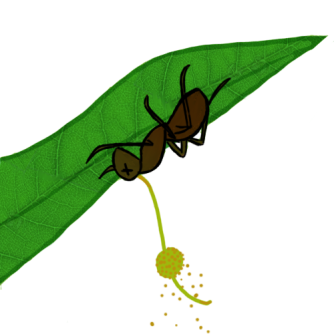

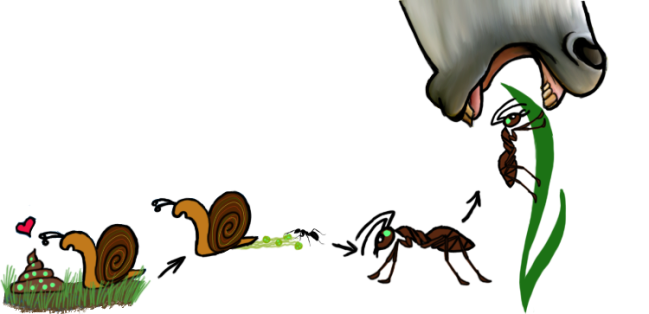
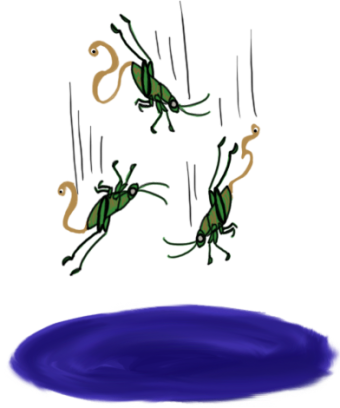
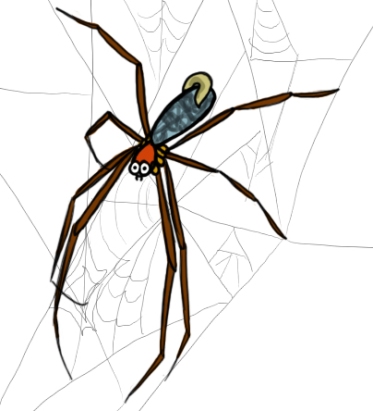
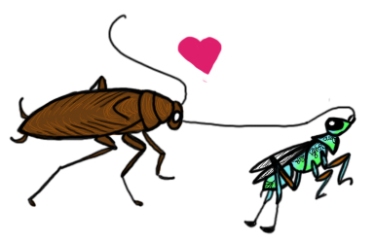
Hi Sarah,
Great blog! I am the Editor in Chief of GOES magazine (https://globalopportunities.co/february-issue/), publishing science student open-access articles and one of my writers wrote about Hymenoepimecis argyraphaga, and I was wondering if I may use your illustration? Your name and blog would be fully referenced.
I am happy to send you over all details via email (boroka.kiss@student.anglia.ac.uk).
Many thanks!
You may certainly use my illustration if you reference my blog. Thank you for asking!
Thank you very much! If you email me – I will send you a copy of how the article will look like and send you the T&C email before publishing so you see how it is published (around 24 May) 🙂
Pingback: Deceit in Nature – Biogeekery